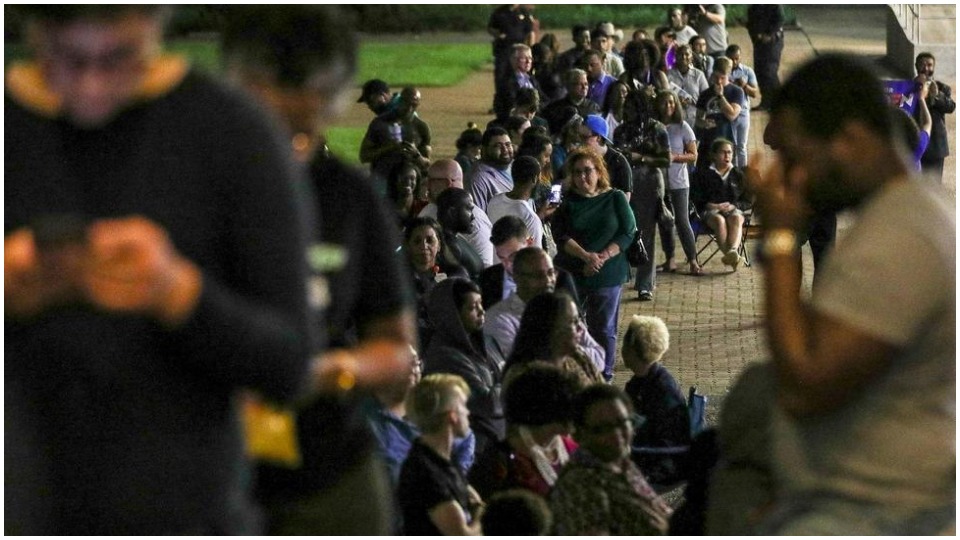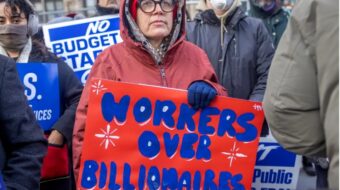
On Friday afternoon last week, Bernie Sanders was forecast to have a 60% chance of going to the Democratic National Convention in Milwaukee this summer with a plurality of pledged delegates; Joe Biden had around a 30% chance. After Super Tuesday, those odds have flipped. The one constant: No one is on track to win a majority of delegates, and this contest will carry on for months. Other takeaways: turnout was up in many states, signaling trouble for Trump, but so was racist voter suppression.
In California, the most diverse and most populous state voting Tuesday, numbers are still trickling in and final allocations might not be known for days, but the clear result of last night’s vote was that the centrist wing of the Democratic Party re-asserted its place as the dominant faction. The left/progressive wing grouped around Sanders held its own but now faces a challenger with the wind at his back.
Exit polls showed, however, that Democratic voters have not bailed on progressive priorities like Medicare for All, the Green New Deal, accessible education, or battling income inequality. But it did show that the overwhelming priority for most people is denying Donald Trump a second term.
And at least 4.5 million people yesterday thought that Biden was the candidate capable of doing that. But over 3.6 million still opted for Sanders, and another 1.6 million gave their support to Elizabeth Warren. This race is still far from over, and with debates and several state primaries still to come, momentum may yet shift again.
Warren pledged to compete in the races still ahead, though her prospects for winning a large number of delegates dimmed, represented especially by her third-place finish in her home state of Massachusetts.
Billionaire Mike Bloomberg, meanwhile, called it quits after his $500 million attempt to buy the nomination was rejected by Democratic voters pretty much everywhere, especially after Warren demolished him on the debate stage. He threw in his lot with Biden.
Wall Street celebrates
Wall Street breathed a sigh of relief Wednesday morning following Biden’s reversal of fortune, with the Dow Jones Industrial Average soaring 523 points at the open. Leading the charge were shares of health care companies and the private insurance industry. Some on the S&P 500—like UnitedHealth, Anthem, Centene, Humana, and Cigna—added a stunning 10-15% to their valuation at the opening bell as fears of “Medicare for All” appeared to melt away. By the end of the day, the Dow had added 1,100 points—the second biggest daily point gain in history.

The sentiment on the trading floor at the stock market was celebratory following Biden’s string of victories that put him in the lead for delegates. Ed Yardeni, chief strategist for a Wall Street investment firm, expressed a clear (and sensationalist) class viewpoint when speaking about Sanders to CNBC:
“Investors fear Bernie because he wants to cut off the head of capitalism by raising taxes significantly on the rich and using the funds to provide free everything to everybody else…. No wonder investors are reacting to him as though he is going to infect us all with the virus of socialism.”
The perception that Warren may soon withdraw from the race was also an exciting prospect for the stock market. Her early front-runner status was built around proposals to break up big banks and tech companies and raise taxes on the wealthy.
The CEO of Ritholtz Wealth Management, Josh Brown, sent out a tweet predicting “Stocks will be even more relieved at Warren’s coming concession as they are at Biden’s big showing.” Despite the red-baiting demonization campaign aimed at Sanders in recent days, Brown admitted that “Wall Streeters have always secretly been more afraid of her than anyone else,” given her experience heading the Consumer Financial Protection Bureau, her knowledge of finance laws, and the perception that she had the ability to build a broader coalition of voters.
The festive atmosphere on Wall Street, however, was matched by Sanders’ determination to carry on a fight against the powerful. In his speech last night, he predicted that his campaign would ultimately win the Democratic nomination and go on to defeat President Donald Trump in November. “We are going to win because we are putting together an unprecedented grassroots, multigenerational, multiracial movement,” he told supporters.
Sanders promised that movement would take on the very crowd that was toasting Biden’s wins on Wednesday morning: “We are taking on the corporate establishment; we are taking on the greed of Wall Street. The greed of the drug companies who charge us the highest prices in the world. The greed of the insurance companies.”
The center consolidates
Exit polling data show that it was not Sanders’s issues that lost on Tuesday; rather, his lower-than-expected totals were due more to tactical voting aimed at beating Donald Trump in November.
Voters in 12 states were asked whether they support Medicare for All, and in all 12 it garnered strong support. Tuition-free college and university education scored majority backing in the five places where voters were asked about it. Even the “socialist” label wasn’t scaring off too many people. Primary voters in four states were asked their opinion; in each of them, more were favorable to socialism than unfavorable to it—Texas and California reached surprising 57% and 53% favorability ratings respectively.
The overwhelming factor motivating voters across the country was picking a candidate they saw as having the best chances against Trump. Late-deciding voters—who made up as many as half of all voters in several states—broke toward Biden at the last moment. Associated Press surveys showed that in Virginia, for instance, half of voters did not decide on a candidate until Super Tuesday, and Biden got 2/3 of them. In Texas, Massachusetts, Minnesota, and North Carolina, it is also late deciders who are thought to have handed Biden his victories.
These were added to the African-American, suburban women, college-educated, and older voters who were already coalescing around Biden—especially in the wake of his South Carolina primary victory. The pile-on endorsements of Mayor Pete Buttigieg, Sen. Amy Klobuchar, and Rep. Beto O’Rourke over the weekend added to the perception of Biden as the consensus candidate.
Sanders’s coalition remained concentrated among younger voters (across racial lines), Latinos, low-wage workers, those in the service economy, and ideologically motivated left or left-liberal voters. His support from these groups was largely locked in well before the primaries on Tuesday, but almost across the board, turnout did not materialize at expected levels. Sanders still scored commanding leads among voters under 30 in most states and did well among those who feel they’ve lost out in Trump’s supposedly booming economy.
But early data prompts questions about the prospects for his grassroots strategy of focusing on youth and those who don’t usually participate in the political process. In several Southern states, his vote totals among these groups were lower than in his 2016 race against Sec. of State Hillary Clinton. Political scientists and Democratic Party strategists have long questioned whether or when the “new demographics” strategy will be influential enough to carry an election. The Barack Obama win of 2008 seemed to herald its arrival, but numbers from Super Tuesday signal uncertainties about whether the 2020 primary can see a similar success.
Turnout was up, but so was voter suppression
Encouraging turnout numbers were tallied in several places, including Virginia, where almost twice as many voters came to the polls than in 2016. It joined states like Nevada and South Carolina, which have seen significant turnout gains over previous elections. That could portend trouble for Trump come November.
But the results of racist Republican voter suppression were also in evidence in many places Tuesday. Reports emerged of voters waiting up to seven hours to cast ballots in precincts where the number of polling places had been cut. For those with work to get to or family to take care of, voting was extremely difficult.
Texas has led the way, shuttering 750 voting locations since Obama’s 2012 re-election, to the advantage of Republican incumbents. As only one example, election officials in McLennan County have closed 44% of polling locations since then, even though 15,000 more people now live there. More than 2/3 of that population growth are Black or Latino. A similar pattern has repeated elsewhere.
An analysis by The Guardian found that the 50 counties with the fastest Black and Latino growth also saw the largest number of poll closures—542 sites. In the 50 counties with the slowest Black and Latino growth, only 34 sites were shut down. Those counties with growing minority populations have seen their overall populations rise by over 2.5 million; the counties with fewer polling location closings actually shrunk by 13,000 people.
This massive voter suppression effort is aimed at cementing Republican power on Election Day, but it undoubtedly also played a role in pushing down totals on Super Tuesday as well. It should be noted that even in bright blue California voters reported long waiting lines in some places as a new voting system came into play.

It will still take a movement
The Sanders agenda still saw mass support on Super Tuesday, but as the vote totals revealed, the left-wing candidate may not be able to win the nomination on the issues alone. If he is to advance against Biden in what is now an uphill fight, he will also have to convince those who haven’t yet cast their ballot that he is the one to beat Trump.
The whole dynamics of this nomination contest changed in just three days. They could change again, but Sanders and the movement around him have work to do. Biden’s campaign—with almost no organization on the ground in many states, less money, and no “movement” around it to speak of—managed to score nearly a million more votes than Sanders. With the next primaries only a week away, the Sanders camp faces a widening delegate gap if changes are not made.
That sobering reality should force a re-think. In short, the movement, the coalition, has to be expanded. Railing against the Democratic Party establishment and pointing out the injustices of contemporary U.S. capitalism have gotten the Sanders movement this far, but it will take more than that. Serious thought has to be given to how to expand the base to include more African-American voters, more voters over the age of 30, more voters outside educated urban areas, more working-class voters in the industrial heartland, and more self-identified Democrats.
Mobilizing all those groups is a challenge not just for Sanders in the immediate future, but for whoever eventually gets the nomination later this summer. Trump and all the outfits grouped around his re-election effort have already put together a campaign war chest surpassing $250 million. They have an entire right-wing media ecosystem at their disposal. And they control the state legislatures and election boards which have made voter suppression a key part of GOP strategy.
To defeat the Trump machine, it’s still going to take a movement.









